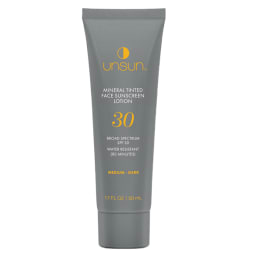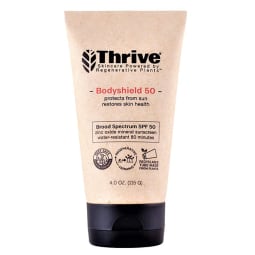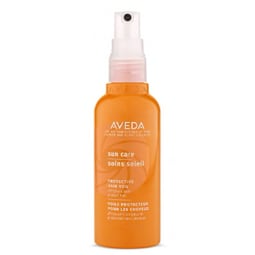Beauty Breakdown: Sun Care & SPF — All The Product Recs, Tips & Expert Advice You Need


Perhaps this is a controversial statement in the beauty space, but I love the sun. I love the way a bright day feels. I love the first glimpse of light in the morning. I love a warm day at the beach and the feeling of baked sand on your toes. I love how people come alive on the first few blue-sky days of spring. I love the feeling that comes with walking outside on a summer day and instantly feeling the sun on your cheeks. I love a sunset, especially when the view is shared over a dinner with loved ones.
But I don't love the potential damage that comes with it. I don't love how easily my skin burns. I don't love thinking back on the sunbathing-as-sport days of my youth. I don't love what sun exposure might mean for my skin health in the future. And so finding a balance between enjoying my precious time in the sun and making sure my skin is protected becomes one of my top skin care priorities.
But how does one protect their skin from UV rays? The simple answer is SPF, but there are actually a lot of other factors that come into play. Here's everything you need to know about sun care this summer.

The 101 on sun care.
Not to be pedantic, but the sun has many benefits. It's quite literally a source of life for our food, provides us with vitamin D, influences our circadian rhythm, and has the ability to affect our moods and emotions. It is also the source of about 80% of visible signs of skin aging1 and a major cause of serious skin issues (the most notable being melanoma).
Ultraviolet radiation has the ability to penetrate the epidermis where it damages the skin cells, proteins, and elastic fibers that keep skin firm. Additionally it can trigger melanin production, which can result in dark spots or "sun spots" in people prone to them. Finally, it has the ability to affect the skin cells' DNA. This all leads to what we call photoaging. "Skin photoaging is a result of the oxidative stress from UV radiation," explains board-certified dermatologist Kautilya Shaurya, M.D.
So how do you reap the benefits while avoiding all the negative effects? Well, it turns out it's a bit more complicated than simply slathering on SPF.

The 5 things we're getting wrong right now.
Even the most diligent skin care devotees can have habits that may be working against them. Here, common skin care practices that may be getting in the way of your best skin yet:
- Skipping daily SPF. Despite the reminders to use sunscreen every single day, surveys indicate that only 11% of Americans do so. And about half of Americans report they never wear sunscreen.
- Forgetting to reapply, especially after getting wet. Given how few Americans wear sunscreen in general, reapplication seems to be a bridge too far. While dermatologists recommend you reapply sunscreen every two hours regardless of your daily activities, you especially need to reapply sunscreen after getting wet (be it from the ocean or sweat).
- Using sunscreen as an excuse to sunbathe. While sunscreen offers protection, it's not a perfect product (no topicals are). It cannot and won't block all UV rays, even if you apply sunscreen perfectly as recommended (and most people don't). So if you apply your product of choice and then sit outside to bake in the midday sun thinking you've done your due diligence, think again. SPF will protect you, but you need to think about the other ways in which you're protecting your skin, too.
- Skipping hand care. The face, neck, and hands are exposed to the most UV rays on a day-to-day basis. And unfortunately protecting your hands from sun exposure is often an afterthought.
- Using photosensitizing ingredients during the day. Some popular skin care ingredients—such as acids, retinols, and some essential oils—are known to increase your skin's sensitivity to the sun. These should only be used at night.

The 5 steps you need to know.
Let's get into what you can actually do to better support your overall skin health while in the sun:
Build out a sunscreen wardrobe.
Once, many years ago, a skin care expert gave me the advice to build out a skin care wardrobe. What did she mean by this? Create a varied collection of SPF options that can be used depending on the body part and circumstance. And why did she give me this advice? When you have sensorially appealing and intelligently designed products, you're more likely to wear them.
Nowadays sunscreens come in so many unique formulas that you don't need to settle for one bottle to serve all needs. The option you might favor for day-to-day facial wear will likely vary quite a bit from what you want to bring to the beach on a hot day—or perhaps you don't like the feeling of lotion at all and will opt for a sunscreen serum. You may want products for a particular area, like an SPF-spiked lip balm or a scalp sunscreen to apply to your part. And you can also collect products that make application easier, like a sunscreen powder or mist.
Be mindful of lifestyle sun safety habits.
We talk about beauty from a holistic perspective here. That means we never stick to just topicals and always look for other ways to support your skin health—be it through diet, mental health, or lifestyle habits. And, well, when it comes to sun care, lifestyle plays a huge role.
About a year ago, I had a conversation with chemist and author of Ingredients George Zaidan on my podcast Clean Beauty School (tune in to the SPF episode here). His conversation turned out to be one of my all-time favorites and changed the way we talk about sunscreen here at mindbodygreen. One of the biggest takeaways I left our chat with was that we can't position SPF as a hall pass to spend all day in the sun, risk-free: "Don't let sunscreen be your excuse to overdose on sun exposure," he says.
"The one thing we know really, really well is that too much sun causes skin cancer—and we have some evidence that sunscreen helps prevent skin cancer. So personally I'm going to tailor my behavior to target both of those things," says Zaidan. "For example, if I had to be out in the sun for a long time in the middle of the day in the summer, yeah, I'll wear sunscreen, but I'll also wear a hat and sunglasses. I will also try to avoid too much direct sunlight—so I won't roast myself on the beach."
Smart sun and skin care requires us to think broadly about our habits and make common-sense lifestyle choices.
Use antioxidant products with photoprotective properties.
As a refresher: An antioxidant is a molecule that neutralizes free radicals in the body. "Free radicals are harmful unstable molecules that can damage your cells or DNA," says board-certified dermatologist Zenovia Gabriel, M.D., FAAD. Free radicals are called "unstable" because they are missing an electron, and when they are unbalanced, they wreak havoc. And this is notable when talking about sun damage as UV rays trigger a cascade of free radicals that results in inflammation and oxidative stress. So as you can imagine, having a stock of free radical fighters at your skin's defense can help remedy this problem.
Additionally, there are certain antioxidants that have been shown via research to have photoprotective qualities. For example, astaxanthin is able to enhance skin photoprotection from UV rays and promotes a healthy inflammatory response. Studies show astaxanthin delays the impacts of UV exposure2, which means less painful bright red skin now and fewer wrinkles later. Another class of antioxidants to look for is resveratrol, which has been shown to help manage UV-induced skin damage3.
We believe in a topical and internal approach for getting your antioxidant fill. Here are our favorite antioxidant serums and supplements for your shopping pleasure.
Learn proper application methods.
Here's another thing people get wrong about sunscreen: Its efficacy is so dependent on user behavior. First up, you need to apply an appropriate amount. You may have a moisturizer with an SPF of 50, but that number quickly dwindles if you're not using enough. As board-certified dermatologist Angelo Landriscina, M.D., notes over TikTok, "The SPF of any product is based on using two milligrams per centimeter-squared on your skin, which is about half a teaspoon for the entire face." (Some experts swear by the two-finger rule for the face.) As for the body, experts recommend a 1-ounce shot glass.
But you also need to apply it correctly—a sunscreen may look and feel like a body moisturizer, but it shouldn't be slathered on like one.
"I learned I've been applying sunscreen wrong my entire life! So many people do this too: They use sunscreen like a moisturizer. What I mean by this is that they'll rub it into their skins until it's completely gone. And at that point, you've massaged it under the top layer of your skin cells. And what you actually want for sunscreen is for it to form a protective barrier above your skin cells," says Zaidan. "I was told by a sunscreen expert that the right way to put it on is to smear it very slightly over the surface of your skin. And then step away, let it dry, and don't touch it. When this dries it actually binds to the top layer of your skin. And, by the way, this is why the bottle says to apply it 15 minutes before doing anything."
This obviously brings up images of the dreaded white cast, so we really do recommend putting in the work to find an option that works for your skin tone.
Regularly visit your derm—and pay attention to your moles.
A regular derm visit to check out your moles is one of the most vital steps in this process. And doing so regularly will mean early detection for any signs of skin cancer. "Early detection is so important. If found early enough, it can be completely removed and cured," says board-certified dermatologist Joshua Zeichner, M.D. "I typically recommend total body skin examinations once a year after the age of 30. In people who have a history of skin cancers or atypical moles, I usually recommend checks twice per year. That being said, at any point, if you notice new or changing spots, visit a board-certified dermatologist for evaluation. Most experts generally agree that new moles can continue to develop until the age of 30. After that age, new moles should be evaluated. If you have a family history of skin cancers, you may be more likely to develop them yourself, so it's important to get checked annually. It's also extra important to get checked if you have had a history of sunburns growing up."
And if you're ever concerned about a mole in particular, it's best to just schedule the visit sooner rather than later. See our guide to when you should get a mole checked out for more information.
Is a derm visit a new concept to you? Understandable, and we all have to start somewhere. If you're not sure what to expect, here's how Zeichner describes it: "Skin cancer checks are quick and easy, but you have to make the appointment. What typically happens at the visit is that the patient gets undressed and puts on a medical gown," he says. "The dermatologist will use a magnifier to look at your beauty marks from your nose to your toes and all the nooks and crannies in between. Certain skin cancers can even develop in areas where the sun does not shine, which is why your dermatologist will even look between your toes and in the private areas."
So, ahem, it might be uncomfortable at first, but please know: "A 10-minute appointment can save your life," he says.

3 extra ideas—in case you want to go all-out.
Looking to go above and beyond? You overachiever, you. Here are some extra tips to supercharge skin:
- Embrace a faux tan. All of the glow, none of the damage. Learn more about how to apply fake tanning products and our favorite options here.
- Use blush to your advantage. Listen, some people like the sun-induced flush look. If that's you, you can fake it with proper blush techniques.
- Protect your precious strands. While your skin is the most important thing to protect against UV damage, your strands can also become frayed and dry from too much time in the sun. Use an antioxidant-rich protecting spray, like the number below, to help shield your hair.

The 6 products to try.
While skin health takes a holistic approach, a few product recommendations can't hurt, no? Here's what beauty experts can't get enough of.
Pros:
- No white cast
Cons:
- Expensive for the size
Lifestyle considerations :
Cruelty-freeSensitive skin-safeOK for blemish-proneWe're fans of mineral sunscreens—as they're the most effective and better for the environment. But that doesn't mean they don't have their downsides. The most notable? A zinc-induced white cast. This popular option comes in a shade for medium to dark skin tones and light to fair. The formula blends into their respective tones easily for everyday wear that protects while evening complexion.
Pros:
- Fast absorbing
- Made with antioxidants
Cons:
- Has a slight (natural) scent, if you prefer fragrance-free
Lifestyle considerations :
Cruelty-freeVeganSensitive skin-safeOK for blemish-proneThis natural brand uses regenerative farming practices, PCR packaging, and clean ingredients. So already we'd consider it a winner in our books. But it also works—like really works. The mineral formula rubs in effortlessly, is hydrating, and doesn't irritate even the most sensitive of skin types.
Advertisement
Best for reapplication: Colorescience Mineral Powder Sunscreen

Pros:
- Absorbs oil & shine
Cons:
- Expensive
Lifestyle considerations :
Cruelty-freeSensitive skin-safeOK for blemish-proneSPF reapplication is hard, especially if you're a makeup wearer. But powder sunscreens act as almost a setting powder. Think of it as a two-in-one: You're protecting the skin from sun damage and minimizing oil and shine midday. This comes in four shades, ranging from fair to deep.
Best antioxidant serum: Naturally Serious Supercharge Anti-Oxidant Moisture Serum

Pros:
- Hydrating
Cons:
- Contains fragrance ingredients, which some people are sensitive to, like limonene, linalool, citral, citronellol, geraniol
Lifestyle considerations :
Cruelty-freeVeganOK for blemish-proneThe base of this hydration-packed product is ceramides, shea, and hyaluronic acid. But the stars are the trio of free-radical-fighting antioxidants: Vitamin E supports the barrier, white birch treats uneven skin tone, and caffeine revives complexion.
Advertisement
Pros:
- Lightweight
- Hydrating
Cons:
- Contains silicones (if you avoid those)
Lifestyle considerations :
Cruelty-freeVeganThis mist coats hair in a water-resistant and lightweight defense layer. While outside, it protects the hair from the sun with antioxidant rich oils. It also infuses hair with hydration, as heat, water, and UV can dry out strands rather quickly.
Pros:
- Soothing & hydrating
- Antioxidant support
Cons:
- It's a rich texture, if you want something thinner & serum-like
Lifestyle considerations :
Cruelty-freeVeganSensitive skin-safeOK for blemish-pronePost sun, you'll want to recharge your skin with hydration and antioxidants. Our lotion's base is made of organic aloe vera, the gold standard of after-sun care. But it's also buffered with oat oil, moringa seed oil, and shea butter for barrier strength. The antioxidants come in the form of a fruit complex and coenzyme Q10, a superpower ingredient that can even support other antioxidants in the skin for even more free-radical-fighting power.
Advertisement

The beauty breakdown.
We tend to think of sun care only in terms of SPF. But given how poor application and usage is, we really should be thinking broader about how we care for our skin during the sunnier months. Of course it's something to think about year-round, but this summer we encourage you to reevaluate your sun habits and perhaps adopt a few new expert-approved tips. Trust us: Protecting your skin from the sun is one of the most important things you can do to ensure skin longevity.



-v1646695196476.jpg?1148x800)